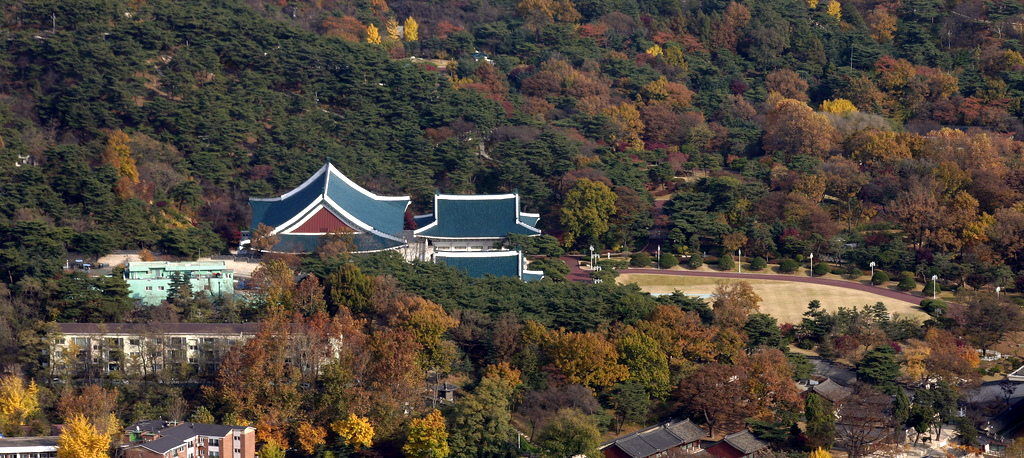- Cheong Wa Dae
Infobox Korean name

caption=
hangul=청와대
hanja=linktext|靑|瓦|臺
rr=Cheong(-)wadae
mr=Ch'ŏng'wadaeCheong Wa Dae (translation: The House of the Blue Roof Tiles or the Blue House, Office of the President of the Republic of Korea) is the executive office and official residence of the
South Korean head of state, the President of the Republic of Korea. Both the English and Korean names refer to the building's blue-green roof. The Korean name has the literal meaning "house of the blue roof tiles." Cheong Wa Dae is in fact a complex of buildings, built largely in the traditional Korean style with some modern elements.At present, Cheong Wa Dae consists of the main office building, the official Presidential residence, Yeongbin-gwan (영빈관, 迎賓館) or the guest house, the Chunchugwan (춘추관, 春秋館) press hall, and the secretariat buildings. The entire complex covers 76,685
pyeong (about 250,000 m²).History
The location of Cheong Wa Dae was the site of a royal villa in what was then Hanyang, the southern capital of the
Goryeo dynasty (918–1392). It was built by King Sukjong (r. 1095–1105) in 1104. Goryeo's principal capital was at Kaesŏng, and it also maintained a western capital atPyongyang and an eastern capital atGyeongju .After the
Joseon dynasty (1392-1910) moved its capital to Hanyang,Gyeongbok Palace was built in 1395, the fourth year of the reign of King Taejo (r. 1392-1398) as the main palace, and the royal villa lot became the back garden of the palace. It was used as the site forcivil service examinations andmilitary training.Following
Japan 's annexation of Korea in 1910, theGovernor-General of Korea used the Gyeongbokgung grounds for the government-general building. In 1939, Japan built an official residence/office for the governor-general on the site of Cheong Wa Dae.With the establishment of the Republic of Korea in 1948, President
Syngman Rhee called the building "Gyeongmudae" (경무대, 景武臺), which was the name of one of the few old buildings there. He used it as his office and residence. PresidentYun Bo-seon changed the name to "Cheong Wa Dae" after he was inaugurated in 1960.In 1968 North Korean infiltrators nearly reached the building. In the ensuing melee, 28 North Koreans, 68 South Koreans and three Americans died.
Presidents
Park Chung-hee ,Choi Kyu-ha andChun Doo-hwan used it both as their office and official residence. While PresidentRoh Tae-woo was in office, a new office building, official residence, and press center, called Chunchugwan, were built. The main office building was opened in April 1991.In 1993, after President
Kim Young-sam 's civilian administration was launched, the Japanese governor-general's residence in the Cheong Wa Dae compound was dismantled to remove a major symbol of the Japanese colonial occupation.etting
Geomancers have long considered the area in which Cheong Wa Dae is located as a lucky location. This view was backed up by an inscription on a stone wall that reads: "The Most Blessed Place on Earth," found behind the official presidential residence during the construction of a new building in 1990.
To the north of Cheong Wa Dae is the mountain
Bukhansan , flanked by twomountain s, Naksan, symbolizing the BlueDragon , on the left and Inwangsan, symbolizing the WhiteTiger , on the right. To the south is Namsan, the protective mountain of the capital. In front flow theCheonggyecheon stream and Han River.ee also
*
Korean architecture
*History of South Korea
*History of Korea
*List of Korea-related topics
*National Assembly Building References
External links
* [http://english.president.go.kr Office of the President]
Wikimedia Foundation. 2010.
